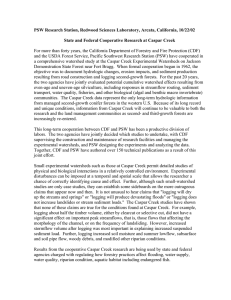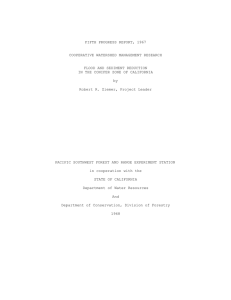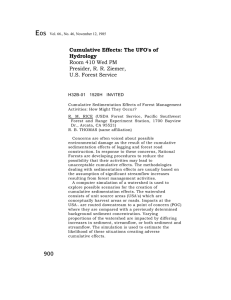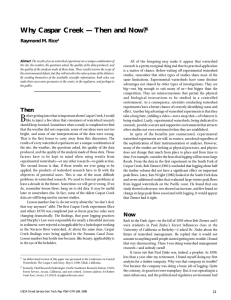CASE STUDIES AND CATALOG OF WATERSHED PROJECTS IN WESTERN PROVINCES AND STATES
advertisement
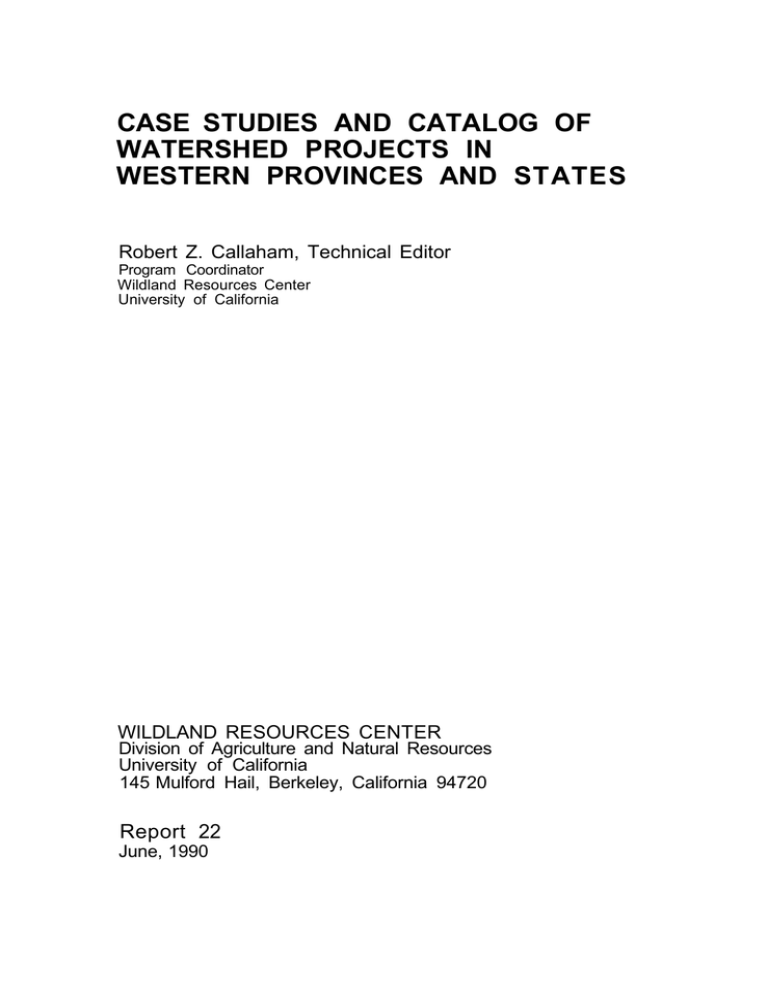
CASE STUDIES AND CATALOG OF WATERSHED PROJECTS IN WESTERN PROVINCES AND STATES Robert Z. Callaham, Technical Editor Program Coordinator Wildland Resources Center University of California WILDLAND RESOURCES CENTER Division of Agriculture and Natural Resources University of California 145 Mulford Hail, Berkeley, California 94720 Report 22 June, 1990 Caspar Creek Experimental Watersheds Robert R. Ziemer, USDA Forest Service, Pacific Southwest Research Station, Redwood Sciences Laboratory, 1700 Bayview Drive, Arcata, CA 95521 Introduction Caspar Creek experimental watersheds are located on the Jackson Demonstration State Forest. Sponsors are the Pacific Southwest Research Station (PSW), USDA Forest Service, and the California Department of Forestry and Fire Protection (CDF). Both organizations have been working cooperatively since 1962. The 483-ha North Fork of Caspar Creek and the 424-ha South Fork of Caspar Creek have been gaged continuously since 1962. The watersheds are Iocated about 7 km from the Pacific Ocean and about 10 km south of Fort Bragg in northwestern California at 39o21'N 123o43'W. Watersheds generally have a southwest orientation. Topographic development of the area is youthful, with uplifted marine terraces deeply incised by antecedent drainages. About 35 percent of the basins’ slopes are less than 17 degrees, and 7 percent are steeper than 35 degrees. Hillslopes are steepest near the stream channel and become more gentle near the broad, rounded ridgetops. Elevation ranges from 37 to 320 m. Soils of the basins are well-drained day-loams, 1 to 2 min depth. They are derived from Franciscan graywacke sandstone and weathered, coarse-grained shale of Cretaceous age. They have high hydraulic conductivities and subsurface stormflow is rapid, producing saturated areas of only limited extent and duration. , The climate is typical of low-elevation watersheds on the central North American Pacific Coast. Winters are mild and wet, while summers are moderately warm and dry. Average annual precipitation is 1,200 mm, and about 90 percent falls 17 during the months of October through April. Rainfall intensities are low. Snow is rare. Prior to treatment, the watersheds supported an 80-yearold second-growth forest composed of coast redwood (Sequoia sempervirens (D.Don) Endl.), Douglas-fir (Pseudotsuga menziesii (Mirb.) Franco), western hemlock(Tsuga heterophylla (Raf.).Sarg.), and grand fir (Abies grandis (DougI. ex D.Don) Lindl.). The forest contained about 700 m3 ha-1 of stem wood. From 1963 to 1967, streamfbw was measured in both second-growth watersheds. In 1967, a main-haul logging road and main spurs were built in the South Fork. The road rightof-way occupied 19 ha, from which 993 m3 ha-1 of timber was removed. The first of three stages of logging began in the South Fork in 1971, during which 59 percent of the stand volume was selectively cut. In 1972, 69 percent of the stand volume was selectively cut from an additional 128 ha. In 1973, 65 percent of the stand volume was selectively cut from the remaining 176 ha. Streamflow, suspended sediment, and bedload have been measured in the two watersheds to the present. In 1985, the study expanded dramatically to evaluate cumulative watershed effects. The current studies of cumulative watershed effects include measurements of solar radiation, precipitation, air and water temperature, soil moisture, groundwater, subsurface pipeflow, streamflow and suspended sediment discharge (at 15 gaging stations), bedload movement, stream channel stability, large woody debris, and anadromous fish habitat. Logging in the North Fork watershed began in 1989. Its intensity and that of road construction will vary among the 10 treated tributaries. The extent of clearcutting in individual tributaries will range from 35 percent to 100 percent. New roads, landings, and skid trails will occupy from 2.8 percent to 13.5 percent of individual logged watersheds. Three tributaries will continue to be measured in an untreated condition. Problems Recent conflicts about forest management center around water quality degradation due to erosion and sedimentation from logging and forest roads and subsequent effects on anadromous and resident fish habitat. Federal and State laws require that soil stability and water quality receive strong consideration in long-range plans. In 1977, a USDA Western Regional Planning Conference considered 579 problems related to the management of public lands. Second in priority was "Improved Data Base and Methods of Analysis to Assess Impacts of Specific Logging Practices on Soil Erosion and Water Quality Characteristics to Evaluate Cumulative Effects”. The concern over "cumulative effects” was relatively new in 1977, but since then it has become a major political and land management issue. It is based on the hypothesis that adverse impacts may be experienced at some point downstream even though all of the activities within the watershed are conducted in a manner which limits their individual effects to an acceptably low level. A key element in the cumulative effects hypothesis is that increases in sediment and/or water resulting from land management activities enter the stream system in small headwater drainages and produce off-site damage in downstream channels. This damage may be increased sedimentation or degraded fish habitat downstream. Virtually no data are available to support or refute the cumulative effects hypothesis. However, much research has demonstrated that rare, unusual events produce the majority of environmental damage and that these events are 18 approximately log-normally distributed in both time and space. That is, most of the land is experiencing a negligible amount of damage most of the time, but a small portion of the land experiences most of the damage within a short period of time. Consequently, land management strategies must be developed that can cope with the episodic nature of environmental damages. Effects of increased sediment on fish habitat are highly complex. New sediment inputs can have positive or negative outcomes depending on the history of sediment routing, channel type the nature of the sediment, channel structure, fish species present, and other habitat changes accompanying sedimentation. Usually sediment increases are detrimental to fish habitat. Therefore, improved methods are needed for evaluating the risk of landslides and erosion and the timing and routing of sediment in relation to cumulative effects and anadromous and resident fish habitat. Without such information, it will be nearly impossible for the land manager to respond in a site-specific way to sedimentation hazards. Objectives Data collected during and after logging and road construc- tion will reflect watershed responses to a wide combination of storm intensities and watershed impacts. These variable responses will be analyzed to determine if synergistic cumu- lative effects are occurring. Specifically, we will test if, for a given intensity of storm and management impact, the watershed response increases with watershed area. If it does, we will conclude that cumulative effects are occurring and we will be able to estimate the magnitude of those effects. Regardless of the outcome of the cumulative effects analysis, the intensity of data collection required by the experiment will undoubtedly provide valuable new insights into the environmental effects of forest management activities. We will also learn much about the mechanisms by which water and sediment are routed through a watershed, how these mechanisms are altered by management. We will also learn what the effect changes in sedimentation, runoff, and organic debris have on fish habitat and the capability of a stream to produce fish. Planning Since 1962, representatives of PSW and CDF have met each year to agree upon an annual work plan and to review the previous year’s plan for accomplishments and failures. During the years, other principal cooperators participated in these planning sessions, but PSW and CDF have been the primary cooperators. These annual sessions have been critical to the success and longevity of the watershed study. Participants include project and station managers and CDF’s counterparts and the principal scientists working on active studies. Attendance ranges from about 5 to 20. At this meeting, the work plan is formulated, budgets are established, and responsibilities are assigned. Individual research studies are coordinated at this meeting to assure that one study does not compromise another on-going study. As the year progresses and revisions to the annual plan are needed,consent from the principals is sought. If the changes are minor, revisions to the plan will be informally noted; if major, the plan is commonly formally revised. With the annual planning sessions and a permanent full-time resident PSW staff at the CDF offices in Fort Bragg, changes to the annual work plan are usually not required, and interagency communication is frequent. Implementation Lisle, T.E. 1989. Sediment transport and resulting During the 28 years of this cooperative study, there have been several cycles of “interest” and financial support. Fortunately, the cycles have usually been out of phase within PSW and CDF--that is, when PSW had budgetary declines, CDF was able to provide additional support. It has been 25(6): 1303-1319. Rice, R.M.; Tilley, F.B.; Datzman, P.A. 1979. A watershed’s response to logging and roads: South Fork of Caspar Creek, California, 1967-1976. Res. Paper PSW-146. important that the directors of both PSW and CDF have been aware of and supported the concept of the study. Apparently, neither party wants to be the one that causes this long-term relationship to falter. PSW has primary responsibility for designing and implementing research studies, with review and concurrence by CDF; CDF has primary responsibility for designing and im- plementing treatments. CDF maintains roads, trails, and structures and administers logging operations. CDF is assisted by inmates from a Department of Corrections’ work camp located nearby. PSW purchases, constructs, and maintains all instrumentation and processes all data. Evaluation Evaluation is an integral part of the annual work meeting. In addition, CDF is actively involved in each periodic technical and administrative review of the research work unit. Technology Transfer Original and continuing purposes of the Caspar Creek study are to develop scientifically valid information and to demonstrate appropriate technology to regulatory agencies and the public, the hydrologic consequences of road construction and logging in this region when commercially available state-of-the-art land management practices are em- ployed. That is a primary purpose of the Jackson Demonstration State Forest. Consequently, there is a continuing interest in the study by users of technology. Tours and presentations are common, and popularized articles appear periodicaIly. In 1989, a 20-minute video on the Caspar Creek study was jointly funded and produced by CDF and PSW. References Eads, R.E.; Boolootian, M.R. . 1985. Controlling suspended sediment samplers by programmable calculator and interface circuitry. Res. Note PSW-376. Berkeley, CA:USDA Forest Service, Pacific Southw. forest and Range Exp. Sta. 8 p. Eads, R.E.; Boolootian, M.R.; Hankin, S.C., inventors: United States of America, assignee. 1987. Means and method of sampting flow related variables from a waterway in an accurate manner using a programmable calculator. U.S. patent 4,660,422. Apr. 28. 9 p. Int. Cl.4 GO1 N 1/44. Keppeler, E.T. 1986. The effects of selective logging on low flows and water yield in a coastal stream in northern California. M.S. Thesis. Arcata, CA:Humboldt State University. I37 p. Keppeler, E.T.; Ziemer, R.R. in press. Logging effects on streamflow: water yields and summer low flows at Caspar Creek in northwestern California. Water Res. Research. Krammes, J.S.; Burns, D.M. 1973. Road construction on Caspar Creek watersheds---a 10-year progress report. Res. Paper PSW-93. Berkeley, CA:USDA Forest Service, Pacific Southw. Forest and Range Exp. Sta. 10 p. deposition in spawning gravels. Water Res. Research Berkeley, CA:USDA Forest Service, Pacific Southw. Forest and Range Exp. Sta. 12 p. Sendek, K.H. 1985. Effects of timber harvesting on the lag time of Caspar Creek watershed M.S. Thesis. Arcata, CA:Humboldt State University. 46 p. Thomas, R.B. 1985. Estimating total suspended sediment yield with probability sampling. Water Res. Research 21(9): 1381-1388. Thomas, R.B. 1986. Calibrating SALT: a sampling scheme to improve estimates of suspended sediment yield. in: Monitoring to detect changes in water quality series (Proc., Budapest Symp., July 1986). Int. Assoc. Hydrol. Sci. Publ. 157, p. 79-88. Tilley, F.B.; Rice, R.M. 1977. Caspar Creek watershed study-a current status report. State Forest Notes. 66. Sacramento, CA:State of California, Department of Forestry. 15 p. Wosika, E.P. 1981. Hydrologic properties of one major and two minor soil series of the coast ranges of northern California. M.S. Thesis. Arcata, CA:Humboldt State University. 150 p. Wright, K.A. 1985. Changes in storm hydrographs after road building and selective logging on a coastal watershed in northern California. M.S. Thesis. Arcata, CA:Humboldt State University. 55 p. Wright, K.A; Sendek, K.H.; Rice, R.M.; Thomas, R.B. In press. Logging effects on streamflow: storm runoff at Caspar Creek in northwestern California. Water Res. Research. Ziemer, R.R. 1981. Stormflow response to road building and partial cutting in small streams of northern California. Water Res. Research 17(4): 907-917. Ziemer, R.R.; Albright, J.S. 1987. Subsurface pipeflow dynamics of north-coastal California swale systems. In: Beschta, R., T. Blinn, G. E. Grant, F. J. Swanson, and G. G. Ice, ed., Erosion and Sedimentation in the Pacific Rim (Proc., Corvallis Symp., August, 1987). Int. Assoc. Hydrol. Sci. Publ. 165, p. 71-80. Ziemer, R.R.; Rice, R.M. In press. Tracking rainfall impulses through progressively larger drainage basins in steep forested terrain. In: Water Resources in Mountainous Regions (Proc., Lausanne Symp., August 1990). lnt. Assoc. Hydrol. Sci. Publ.. xxx. Watershed Name: Caspar Creek Report by: Robert Ziemer, Redwood Sciences laboratory, Pacific Southwest Forest and Range Experiment Station, 1700 Bayview Drive, Arcata, CA 95521, (707) 822-3691 Location: Nearest Town, Fort Bragg, CA County or Region: Mendocino Township and Range:Tl7N, Rl7W, MDM Problem Statement and Study Objectives: study is designed to evaluate cumulative watershed effects: that is, that adverse impacts may be experienced at some point downstream, even though all of the activities in the watershed are conducted in a manner which limits their individual effects to an acceptable low level; specifically, we will test if for a given intensity of storm and management impact, the watershed response increases with watershed area Treatments: calibration, 1962 ongoing; road construction (S. Fk.), 1967; selective logging (S. Fk.) 1971-1973; clearcut logging (N. Fk.), 1989 ongoing Expected or Final Results of Treatments: the extent of clearcut logging in the individual treated tributaries will vary from 35 percent to 100 percent; three watersheds will remain as uncut controls; we will evaluate the effect of treatments on sedimentation, runoff, and fish habitat Cost Estimate: $500,000+ per year Watershed area and size of treated area: North Fork, 508 ha; South Fork, 424 ha; within North Fork are 17 nested watersheds ranging from 0.8 ha to 380 ha Stream gradient and order: 18 nested watersheds ranging from zero to fourth order with stream gradients ranging from 0.4 percent to 10 percent Geology and soils: sedimentary rocks (sandstone and shale) of Cretaceous Age; Irmulco and Tramway soil series; Vandamme; Dehaven; Hotel; Caspar series (in order of abundance) Topography, aspect, and elevation: 30-70 percent slopes (7 percent are >70 percent slope); south-southwest; 37-320 m elevatbn Vegetative cover type and density: second growth redwood and Douglas-fir; hemlock; grand-fir 700m3/ha Climate and precipitation: coastal climate; mild wet winters; cool summers with coastal fog; snow extremely rare; 1,190 mm average precipitation (838-1,753 mm range) Land ownership: 100 percent California Dept. Forestry and Fire Protection Access restrictions due to weather or owner: gravel roads, some locked gates; permission obtained from CDF in Ft. Bragg Contacts: Robert Ziemer, Redwood Sciences Laboratory, Pacific Southwest Forest and Range Experiment Station, 1700 Bayview Drive, Arcata, CA 95521, (707) 822-3691; F. Tilley, Department of Forestry, Fort Bragg, Ca (707) 9645673 Sponsors: USDA Forest Service, Pacific Southwest Forest and Range Experiment Station; California Dept. Forestry and Fire Protection Descriptive publications and reports: Keppeler, E.T.; Ziemer, R.R. in press. Logging effects on streamflow: water yields and summer low flows at Caspar Creek in northwestern California. Water Resources Research; Krammes, J.S.; Burns, D.M. 1973. Road construction on Caspar Creek Watersheds-a 10-year progress report. Res. Paper PSW-93. Berkeley, CA:USDA Forest Service, Pac. Southw. forest and Range Exp. Sta., 10 p.; Rice, R.M.; Tilley, F.B.; Datzman, P .A. 1979. A watershed’s response to logging and roads: South Fork of Caspar Creek, California, 1967-1976. Res. Paper PSW-146. Berkeley, CA:USDA Forest Service, Pacific Southwest Forest and Range Experiment Station, Berkeiey, CA. 12 p.; Wright, K.A., Sendek, K.H.; Rice, R.M.; Thomas, R.B. in press. logging effects on streamflow: storm runoff at Caspar Creek in northwestern California. Water Resources Research
